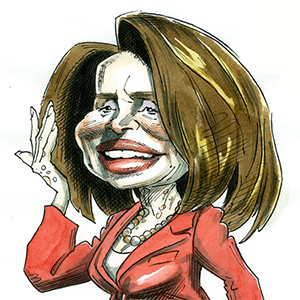At Beverly Hills High, Trump victory celebrations ignite simmering racial tensions
Published in News & Features
LOS ANGELES -- A high ranking administrator in the Beverly Hills Unified School District had an urgent, confidential message for the school board.
It was Oct. 27, just over a week before the presidential election, and tensions at Beverly Hills High School between Persian Jewish students and Black students were quickly escalating, wrote Laura Collins-Williams, an assistant superintendent for student services in the district. The school year had already seen a flurry of confrontations and fights and a even video that circulated of a student uttering a racial slur, she wrote.
“We must act urgently to prevent further violence,” Collins-Williams wrote. “Without immediate intervention, I fear violence will prevail.”
The message was ominous, but the messenger had a complicated history. For nine months, Collins-Williams had been embroiled in her own battle, accusing the district in a lawsuit of racial discrimination and retaliation, which the district has denied.
The highly flammable situation caught fire last month, when pro-Trump students at Beverly Hills High School held two days of what the district termed“spirited demonstrations” to celebrate the election results.
Boisterous students chanted pro-Trump slogans and carried flags mounted on poles throughout the school — but some Black students said racial slurs and racist rhetoric were used. The rallying students knocked on and tried to open the door of the classroom where the Black Students Union was meeting, which caused some of the teens and the teacher in the room to fear for their safety.
“All I could see at the door was a huge Trump flag on a pole. They’re asking me to open the door. I grabbed the handle because I didn’t want them to come in,” said Bella Ivory, the teacher whose classroom the demonstrators were trying to enter. Ivory, who is Black, said the situation upset her mental health and led her to take numerous days off from school.
“It’s just me and seven Black kids in my classroom. I was so upset. So afraid,” she said.
::::
The pro-Trump demonstrations at Beverly Hills High School were foreshadowed by a mock election run by the Associated Student Body in conjunction with the school’s Social Studies department.
While the Beverly Hills precinct where the school is located had a tight margin in the presidential election — with Trump taking 49% of the vote compared to Harris’ 48% — students voted for Trump by a wider margin.
The day of the election and the day after, Trump supporters at the school rallied rowdily in courtyards and hallways, shouting pro-Trump slogans as they rushed around the school.
The rallies made many students who don’t support the former president feel uncomfortable.
“Students were seen screaming profanity throughout the two rallies and were aggressive to those with opposing views. Everyone has the right to express their political views, but countless students and teachers felt unsafe with the crowd’s mob-like behavior,” wrote the editors of Highlights, the high school’s student-run publication.
In the aftermath of the second day’s demonstrations, the school limited students’ ability to assemble in groups. Students would no longer be able to “congregate, circle up, shout, jump, etc.,” wrote Principal Drew Stewart in an email to students and families.
“That there was some energy behind the election outcome was a positive sign,” said board member Amanda Stern. “To me, it demonstrated that these groups of students were prepared and willing to exercise their civil rights and expression. The difficulty we faced was in part due to the nature of teens who can naturally be self-directed. To that end I feel our administrators appropriately managed the situation.”
But the political demonstrations gave rise to another debate over race. Were Black students and a Black teacher targeted by the demonstrators? And if so, for what purpose?
::::
Security footage from outside Ivory’s classroom shows dozens of students walking past during lunch on Nov. 5, Election Day, some wearing Trump hats and others carrying Trump flags.
The minute-long video, released to The Times as part of a public information request, shows one student try to open the door to Ivory’s classroom. Others rap and knock on the door at various times, though their manner does not appear threatening. At one point in the video, the door briefly opens from the inside and quickly swings shut again. Most students walk right by the room.
Days after the incident, at a school district board meeting, Ivory and students from the Black Student Union spoke about the fear they felt during the rally.
“Kids banging on the door and rattling the handle and I’m holding onto the handle thinking, ‘My gosh, if they get in here, what am I going to do?’ Because I have to protect these kids.” Ivory said.
One student, Alexander, said some of the high schoolers in Ivory’s classroom “feared for their lives” as the “mob” chanted outside. Another member of the Black Student Union said she was called a slur by a student carrying a flag.
Attempts to reach pro-Trump demonstrators were unsuccessful.
The district carried out a “thorough investigation” of what happened outside Ivory’s classroom.
“While findings addressed their concerns and reinforced a commitment to respectful discourse, the video of some of the allegations made, requested under the federal Public Records Act, gives clarity in contrast to some assertions,” the district said in a statement to The Times.
Stern also pushed back against the narrative coming from students in the Black Students Union and Ivory.
“We cannot act on allegations that prove to be false,” she said. “There have been both adults and children who have claimed certain words or actions have occurred at specific times and places. A thorough investigation, to date, has not corroborated those claims... We can’t discipline individuals if we don’t have proven allegations.”
“We have no record of a report of a racial slur being used,” the district said.
Weeks after the board meeting, Ivory said that neither she nor the students had planned to speak at the meeting — they were asked to speak by assistant superintendent Collins-Williams.
::::
The school district, a rarity in Los Angeles County with a majority white student body, has had issues with allegations of racism in its past. Black students make up just under 3% of the students.
Less than a decade ago, Beverly Hills paid nearly $700,000 to Carter Paysinger, the first Black principal of the high school. Paysinger had sued the district in federal court, saying he was discriminated against while in the position.
In 2017, just two years after settling the lawsuit with Paysinger, Beverly Hills Unified School District hired Collins-Williams as assistant superintendent of student services.
Collins-Williams, who is Black, sued this year alleging that the district allowed a “culture of racism to permeate and ferment throughout BHUSD school sites, traumatizing students, parents, and staff who are African Americans and other persons of color.”
She claimed to have been passed over for the job of deputy superintendent, which she said she was being consider for.
The district denied in a response to the lawsuit that it has discriminated against Collins-Williams.
Moreover, some longtime school district leaders pushed back on the idea that the district is not taking racism issues seriously.
“I can tell you the school board takes a strong stand and is very vocal against racism and antisemitism, and the school has policies and procedures in place for any incidents and acts on [them] very quickly,” said Mary Wells, a Beverly Hills City councilwoman and former board president.
“We are confident in the integrity of our processes and remain focused on maintaining a positive and inclusive environment for all.”
Despite the ongoing legal battle, Collins-Williams remains in her role as assistant superintendent.
::::
It was under the shadow of her lawsuit that Collins-Williams wrote in October in the Board Connection that tensions between Jewish and Black students were rising.
“Black students at Beverly Hills High School have expressed to trusted staff members that they feel marginalized, invisible, devalued and unsupported by the school community,” she wrote. “They also feel unprotected and unsafe as many report being called the N-word on a near daily basis. Black students are particularly distressed that the focus on campus is primarily centered around the Israel-Palestine conflict and the pain of Persian Jewish students, while their own experiences of discrimination and racism are overlooked.”
She cited anonymous accounts that painted a worrisome picture of escalating racial tensions at the school.
A Black student, according to Collins-Williams, was confronted by a group of Jewish students on Halloween in 2023 over a pro-Palestinian post.
The tensions from that incident led to a fight on campus the next month between the Black student and one of the Jewish students involved in the original confrontation, she said.
The Beverly Hills Police Department was then called to respond to a battery at the campus on Aug. 20, though they did not take a report, the department said. One of the two students was hit in the back of the head with a computer during the fight, according to a police incident log.
In October, the Black student was followed home and “verbally accosted” by students, according to the memorandum. The Black student is now “facing legal consequences after responding physically to being called the N-word on campus,” Collins-Williams wrote.
Collins-Williams also said a video had surfaced of a racial epithet being whispered.
But the school district disagreed with parts of Collins-Williams’ report in the Board Connection that warned of racial violence. The report represents her views; it was not endorsed by the district.
“Dissemination to the Board indicates that the document was reviewed, not necessarily endorsed,” the district said.
They denied a racial epithet could be heard in a video that was reported to the district by two parents.
“No such epithet was confirmed in the video nor was it reported by students to administration,” Supt. Michael Bregy said in a statement to The Times.
They downplayed Collins-Williams’ concerns that the fights between the two students were race or ethnicity related. No pro-Palestinian post was mentioned by the district. Bregy said the initial fight was “purportedly influenced by a social media post from a year prior,” but did not specify what the post was.
“Due to the layered nature of teenagers, it is not unusual for two students to have an isolated dynamic between them which requires restorative practices,” he said.
Some Black students at the school do feel targeted by racist taunts. A freshman girl who is Black told The Times that white students routinely ask for an “N-word pass” from Black students so they can use the racial slur.
“Sometimes they’ll say, ‘Hey, my ni— ,’ but they won’t fully say it,” said the ninth-grader. The girl also said there is a trend where students speak in an African click language that went viral on Tik Tok. Students will mimic the click language to speak with Black students, the girl said.
The argument over race relations backs up into the lawsuit filed by Collins-Williams.
Collins-Williams’ lawyers did not make the assistant superintendent available to speak with The Times.
Ivory has not returned to Beverly Hills High School out of fear for her safety since the election demonstrations. She said she has been maligned and threatened online for speaking out about her experience.
She has retained attorney Bradley Gage and is planning to file a lawsuit against the district.
©2024 Los Angeles Times. Visit at latimes.com. Distributed by Tribune Content Agency, LLC.










Comments